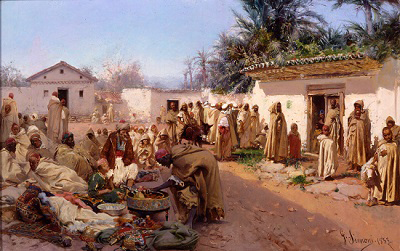Gustavo Simoni (Italian, 1846–1926)
Arab Market Scene, 1883
Oil on canvas, 9 x 14 1/8 in.
Signed and dated lower right: G. Simoni 1883
1997.43

Born in Rome, Gustavo Simoni trained at the Roman Academy of St. Luke for five years with Salvatore Betti. A successful oil painter and watercolorist, Simoni is best known for his Orientalist scenes derived from his experiences in North Africa and the Middle East. Traveling abroad, Simoni utilized his images according to the standard academic tradition: sketching from life during his various journeys, he would later turn this source material into finished compositions once back in the studio. Simoni made his first trip to Spain and North Africa in 1875, followed by a more extensive trip to Tunisia and Algeria 1877–79. He continued to make trips to North Africa through the 1880s and 1890s. Simoni exhibited regularly from the mid-1870s until 1915, showing his works internationally at exhibitions in Germany, France, England, Spain, and Africa as well as his native Italy. In 1875, Simoni became one of the founding members of the Watercolor Association of Rome, and in 1889 he received an honorable mention at the Universal Exposition in Paris.
Arab Market Scene is the type on-site composition that Simoni developed into paintings in his studio from travel sketches in North Africa and the Middle East. Although best known for his Orientalist works depicting mosques and other Islamic subject matter — he was particularly fascinated with the village festivals he witnessed in North Africa — Simoni also created images of everyday life, like this market scene, which depicts the daily workings of a village community conversing, walking, and selling beautifully crafted, decorative wares. There is a documentary quality to Simoni’s Arab Market Scene. It lacks the vibrant colors, patterns, and fantasy of North African life often found in Orientalist works. Instead, Simoni carefully represents the sandy colors of the hooded cloaks and the exposed soil, and the whiteness of the buildings, only minimally punctuated by the vibrancy of the striking goods for sale in the lower left corner or the verdant patch of grass and foliage in the upper right. Having spent two full years in Tunisia and Algeria in 1877–79 and additional shorter trips to the region in the 1880s, Simoni would have had ample first-hand experience with scenes of daily life like this.


